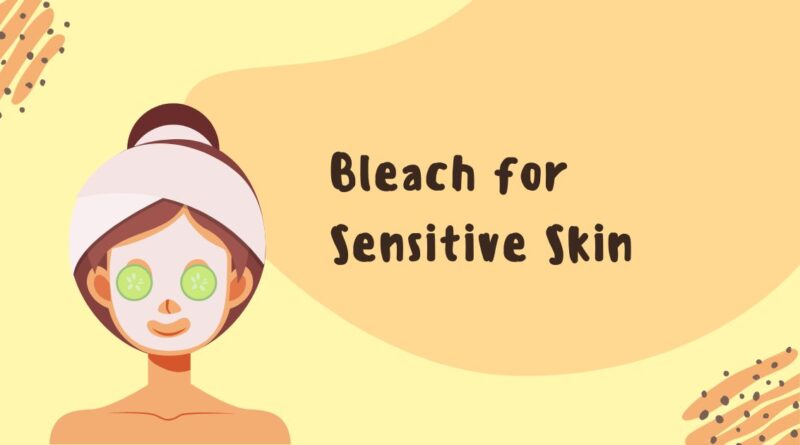The Ultimate Guide to Using Bleach for Sensitive Skin: Tips for Safe and Effective Use
Are you considering using peroxide on Sensitive skin but are worried because of concerns about its potential force? You’re now not on my own. Many human beings with touchy pores and pores and skin fear approximately the terrible results of bleach. However, while used efficaciously, bleach can be a precious device for maintaining cleanliness and hygiene without demanding your pores and skin. In this whole guide, we can discover the manner to securely and correctly use bleach on touchy pores and pores and pores and skin, supplying you with tips and precautions to ensure a terrific level.
1. Understanding Bleach and Sensitive Skin
Recognizing what peroxide is and how it works on pores and skin is essential when entering into the specifics of applying agents to people with delicate skin. It is a potent antiseptic that is widely employed for both cleaning and disinfecting various items. However, potash, a component of it, can result in irritation, particularly in those with skin that is highly susceptible. It’s vital to proceed with caution and take appropriate measures to reduce functionality-damaging reactions.
2. Choosing the Right Type of Bleach
Not all bleaches are created the same, and selecting the proper type is vital whilst coping with touchy pores and pores and pores and skin. Use bleach remedies that are mild or environmentally friendly, or that are made especially for people with delicate skin and wrinkles. There is very little chance that those goods include harsh chemicals or compounds that would increase your skin’s pores.
3. Diluting Bleach Properly
One of the maximum vital elements of the usage of bleach correctly on touchy pores and skin is proper dilution. Never observe undiluted bleach right away on your pores and pores and skin, as it can cause severe contamination and chemical burns. Instead, dilute bleach with water consistent with the manufacturer’s commands. A not unusual dilution ratio is one detail bleach to nine factors water for popular cleansing abilities. However, for touchy pores and skin, it’s recommended to use a very good greater diluted technique to decrease the hazard of infection.
4 . Performing Patch Tests
Before the use of bleach on big areas of your frame, it is crucial to behavior patch assessments to evaluate your skin’s response. To test for proof of defilement or acute reaction, apply a small amount of bleach in a diluted state to a small strip of skin and pores that includes the inner elbow. Then, watch the area for at least two days. Avoid using bleach on your skin or pores if you like redness, itching, or puffiness. Also, remember to use additional cleansing techniques.
5. Taking Precautionary Measures
When the use of bleach for Sensitive skin, it’s far vital to take precautionary measures to defend yourself from capability damage. Wear gloves and defensive clothing to save you from direct touch between bleach and your pores and pores and skin. Additionally, ensure appropriate sufficient ventilation inside the place in which you use bleach to lower inhalation of fumes, which would get worse the respiratory tract.
6. Alternative Cleaning Methods
If you’re hesitant about using bleach in your sensitive pores and pores and pores and skin or enjoy negative reactions no matter taking precautions, do not worry there are hundreds of opportunity cleansing techniques to be had. Consider using natural cleaning solutions alongside facet vinegar, baking soda, or hydrogen peroxide, that are effective but gentler on touchy pores and skin.
Conclusion:
Bleach can be a useful cleaning agent for human beings with sensitive pores and pores and skin whilst used efficiently and with caution. By following the guidelines stated in this manual, you may thoroughly incorporate bleach into your cleansing habit without compromising the health and comfort of your pores and pores and skin. Remember to pick the proper form of bleach, dilute it nicely, perform patch assessments, and take precautionary measures to lower the risk of infection and allergies. With the proper method, you can enjoy the advantages of clean and clean-up surroundings without sacrificing the well-being of your sensitive skin.
Frequently Asked Questions:
Using bleach on sensitive pores and skin requires warning. Although Clorox is a powerful cleaner, some persons may experience allergy responses and discomfort from the active compound, sodium chlorine. But, you can lessen the likelihood of adverse effects by carefully diluting bleach and adopting security precautions, such as wearing hands and protected clothes.
It is necessary to combine bleach with water just before applying it to the skin that is delicate and lips. A not-unusual dilution ratio is one detail bleach to 9 factors water for ultra-modern cleaning features. However, for sensitive pores and pores and pores and skin, it is recommended to use a good greater diluted option to reduce the probability of irritation. Always observe the producer’s commands for diluting bleach properly.
Undiluted bleach can motivate chemical burns and intense infection whilst implemented straight away to the pores and skin, especially sensitive pores and skin. To save you this, in no manner use bleach without diluting it with water first. Additionally, carry out patch checks on a small region of skin earlier than the usage of bleach on large regions to evaluate your pores and skin’s reaction and keep away from ability burns or contamination.
If you’re concerned about the use of bleach for your touchy pores and skin or experience destructive reactions irrespective of precautions, there are alternative cleansing techniques to be had. Herbal remedies for cleaning that contain peroxide, hydrogen peroxide, vinegar, and also or soda from baking are potent cleaners that are kinder to delicate skin and pores. Likewise, you can purchase industrial cleaning solutions that are advertised as insensitive or suitable for people with sensitive skin.
Stop using bleach promptly and rinse the area of concern with lots of water if you notice any redness, itching, or soreness after applying it to your small pores. Use the gel form of aloe vera or a calming cream free of smell to help relieve the pain. If the symptoms persist or get worse, consult a dermatologist for additional evaluation and treatment options.





